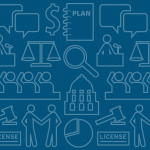This month, we highlight how laws and policies can establish decision-making processes and accountability measures that connect closely to outcomes rooted in the public’s health, actualizing the value that all people deserve a fair opportunity to live their healthiest life.
Public health authority is the specific legal power to govern public health decision making within and across issues. We have been tracking the uses and abuses of legal tools that affect public health authority by restraining, reallocating, or removing public health practitioners’ ability to use well-established methods of protecting health and well-being — both in emergencies and in countless day-to-day ways. We’ve seen how some courts have reinterpreted public health authority in order to downplay or even sidestep its underlying purpose of serving the public’s health, and we’ve also seen what happens to health in jurisdictions where these types of activities have been successful.
We have also begun to partner with practitioners and advocates to create a framework based on the “bright spots” that show how laws and policies can improve and preserve the practice of public health. What legal mechanisms can be (and have been or should be) used to embed effectiveness, responsiveness, and equity in public health decision making?
Laws and policies that determine public health authority can include goals, processes, financial implications, and the ability to direct the activities of others. These elements affect health outcomes and health equity, regardless of stated (or implied) intent and regardless of whether their impacts are actually measured. Better laws and policies governing public health authority can explicitly connect these elements to outcomes and accountability measures that have been shown to improve the public’s health more efficiently and equitably. Here are some examples:
- Legal tools can establish clear goals tied to the latest evidence base and local efforts — for example, in “whereas” statements in the introductory text of an ordinance. Legal tools can also set standards (baselines or caps) and facilitate evaluation efforts to improve and iterate on how those goals are pursued. Equity-focused outcome measures must be carefully considered to comply with constitutional and other legal requirements, but they are essential in order to reduce disparities and advance long-term public health goals like securing foundational public health services for all, improving investments to address social determinants of health, and alleviating structural drivers of health inequity.
- Legal tools can set forth processes for decision makers in local or state agencies or other representative bodies who are exercising their public health authority. Procedural requirements can provide important checks, can improve data access and use, and may require certain participants — such as staff and experts in relevant sectors, trusted community groups, and residents — to inform and implement public health activities.
- Legal tools can create stable funding to support public health staff and services with training, guidance, technology, and materials. For example, sustained funding structures can support cross-sector partnerships that reflect the interconnected nature of public health interventions — including partnerships with community-based organizations functioning as service providers and trusted community institutions. Laws and policies influencing the allocation or use of funds — whether through requirements or limitations — may sometimes be used to promote specific goals or processes.
- Legal tools can also determine public health practitioners’ power to influence the activities of others. Legal tools can require or allow public health activity related to specific issues like food inspections, emergency response, housing services, and structural discrimination. Review and enforcement measures can be used to hold public health actors accountable for public health processes and outcome goals. Legal tools can also set time limits on permitted or prohibited activities — for example, in declarations of a state of emergency, during which public health officials are given more flexibility to facilitate rapid-response efforts.
We have seen how these legal tools can be used to help or harm the public’s health, and we’re striving to name and bring a wider audience to the uses that have been proven to help it. Achieving a more effective and more just public health system is a massive undertaking, spanning decades, jurisdictions, political beliefs, and sectors. Laws and policies are only one set of tools in our toolbox as we pursue that shared vision, but we are committed to making use of those tools as best we can. We hope you’ll join us!
2/27/2024
